|
| |
Family Reduviidae
- This page contains pictures and information about Common Assassin Bugs that
we found in the Brisbane area, Queensland, Australia.
-
 - Body length 25mm
-
- This assassin bug is large in size. They are common in Brisbane bushes. We often find them
hunting on plants when we looking for other insects. We found them in
our backyard a few times. They are known as Bee-Killers because they favorite
on hunting honey bees. They
attack any soft body insects include caterpillars.
-


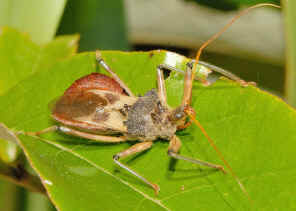 -
- As all other assassin bugs, Common Assassin Bugs have the long head with powerful
proboscis. They use the powerful
proboscis to puncture their prey. Their legs are long so that they have long
attack distance. Adult bugs are brown in colour with transparent wings. Nymphs are
dark brown to black with brightly
orange abdomens.
-
   -
- Females lay clusters of long red eggs. Nymphs pass through five growth stages to become an adult bugs. They are
develop in incomplete metamorphosis. The nymphs look similar to the adult excepts smaller and wingless.
Last instars have wing buds but still cannot fly.
-


 -
- As most Assassin Bugs, it is bright orange in colour with
black legs and long antenna. Notice its strong and long mouth part, also
know as Rostrum, is used for punch into their prey's body
and suck their juice. They will give a very painful bite, so don't touch them.
-
-



-
- This adult Common Assassin Bug found on a oak tree in Wishart in mid-winter.
They have their distinct neck between thorax and head. They are predators of
other small insects and spiders. We see quite a
number of them in winter but rarely see them in summer. We do not think they
are active only in winter. The reason could be because there are plenty of food
in summer. They can find prey easily and spend most of the time for hiding.
In winter they have to wander around and look for prey.
-
 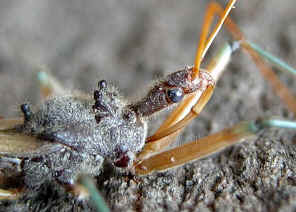  -
- The picture show the close-up of the head of the Assassin Bug. Their piercing-sucking mouthparts,
or Rostrum,
can easily be seen which curve back towards body when not in use. They are used for punch into their prey's body
and suck their juice. A bite from them can be very painful.
-


 -
- In early summer, we saw this Bee-killer hiding on a grass behind a
bundle of flowers, which was visiting by many honey-bees.
-


 -
- Above picture shows the Assassin Bug feeding on a caterpillar.
-


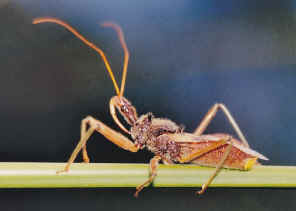 -
- The body colours of this assassin bug are variable between individuals.
They get darker with age.


 -
Eggs, each size 1mm X 3mm
-
- In late summer 2004, we found a Common Assassin Bug and hoped that it was a
female. We kept it in a large jar and fed it with caterpillars. About a week
later, the Assassin Bug laid a batch of eggs under the cover which we used to
enclosed the jar. The bug soon dead after laying those eggs.
1st Instars
 
 - Common Assassin Bug 1st instars, body length 5mm
-
- About two weeks, many small bugs came out from those eggs. The small
bugs looked like black ants with orange abdomen. It would be hard to feed
those small bugs. We put them on the plants in our backyards.
-
2nd Instars


 - Common Assassin Bug 2nd instars, body length 10mm
-
- Few weeks later in the early winter, we found this 2nd instars in the bush.
We can see its strong mouth-parts well ready for hunting.
-
3rd Instars

 -
- This nymph was found on gum tree trunk.
-
4th Instars
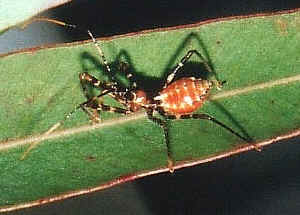  - Body length 15mm
-
- We found this Common Assassin Bug nymph when it was chasing a small Flower
Spider on the Hibiscus plants. There was in our backyard in a mid autumn night. Its wings are not yet developed.
-
5th Instars


 -
- This is the fifth instars Common Assassin Bug we found in later winter.
Notice its developing wing buds. The abdomen can be much larger if they are
fully feed.
-



-
 
 -
- Later in the coming years, we sometimes found this bug in our backyard.
This bug might already established in our backyard.
-

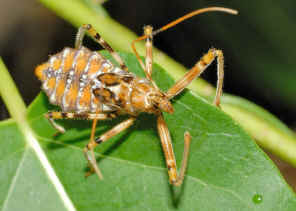
 -
- Reference:
- 1. Insects
of Australia, CSIRO, Division of Entomology, Melbourne University
Press, 2nd Edition 1991, pp 496.
- 2. Insects of Australia and New Zealand - R. J. Tillyard, Angus
& Robertson, Ltd, Sydney, 1926, p150.
- 3. Wildlife
of Tropical North Queensland - Queensland Museum Publications 2000, p91.
- 4. The generic classification of the Australian Harpactorinae (Hemiptera: Reduviidae) -
Malipatil, M.B. 1991. Invertebrate Taxonomy 4: 935-971.
- 5. Revision of Australian
Pristhesancus Amyot and Serville (Heteroptera, Reduviidae) - Malipatil,
M.B. 1986, Australian Journal of Zoology 34(4) 601 - 610.
Back to top
[ Up ] [ Small Red Assassin Bug ] [ Ants Killer Assassin Bug ] [ Red Spiny Assassin Bug ] [ Brown Spiny Assassin Bug ] [ Orange Assassin Bug ] [ Large Orange Assassin Bug ] [ Red Tiger Assassin Bug ] [ Long Assassin Bug ] [ Common Assassin Bug ] | |
|


















































